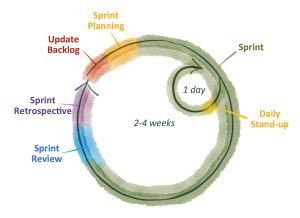Collecting the data you need and analyzing it effectively can be a huge challenge. Contributor Tamar Weinberg explains how to focus on the right metrics to drive conversion and revenue.
 To what extent does data actually drive your marketing decisions? The way I see it, you probably fall into one of the three following categories:
To what extent does data actually drive your marketing decisions? The way I see it, you probably fall into one of the three following categories:
- Intuitive — Your marketing decisions aren’t data-based; intuition drives them.
- Inspired — You value data and consider it in some way, shape or form.
- Intelligent — Marketing data rules the decisions you make.
As marketing evolves as a discipline, so do the roles that marketing executives play in the contexts of organizations. Today, we’re increasingly reliant on data to optimize our strategies and demonstrate the value of our activities.
How has data dependence been working out for marketing professionals? According to a recent report from 3Q Digital, 57 percent of senior marketers are satisfied with how much influence data has over their marketing decisions, and 56 percent are satisfied with how easily they can access the data they need.
In more good news, The Analytics Advantage, a report published by Deloitte on the state of data analytics in successful businesses, claims that “senior executives are realizing that good data can yield good decisions, if captured, analyzed, communicated, and acted upon in a timely and efficient fashion.”
If there’s bad news, it’s simply this: Not all the data is “good data.” Marketers all too often pay attention to the wrong metrics.
Collecting the data you need
Too many businesses lack the capability to collect the data they need and analyze it effectively. The challenge is to:
- collect data from multiple sources.
- identify key metrics and analyze them easily.
- gather the insights needed to make smart and speedy decisions.
No doubt, data collection can be daunting. Those aiming to be a part of the “intelligent” camp toil with data by crawling their way through a myriad of analytics tools, and ultimately, trying to piece the useful stuff together manually.
Enter the dashboard generation. A number of companies are addressing these issues by building tools to make it easier to create more comprehensive views of marketing metrics — including social media analytics — with consolidated dashboards.
- Cyfe merges data from dozens of platforms and presents them in a singular dashboard designed to deliver, at a glance, the insights you need most.
- Supermetrics gives you the ability to collate data from the leading social networks — as well as advertising, analytics and SEO platforms — into Excel or Google spreadsheets.
- Segment offers a suite of data collection and distribution solutions to help your team extract valuable metrics from various streams, merge the data and push it to your data warehousing, analysis or visualization platform of choice.
- Raven Tools offers a drag-and-drop reporting tool for compiling metrics from social, web analytics and PPC platforms into snazzy client reports that you can schedule for automated distribution via email.
Collecting data into a dashboard is the first step. You then need the ability to share insights from your dashboard with the team members who’ll make decisions based on it — fast.

Cyfe dashboard
Why the emphasis on speed? According to a 2015 study from Forrester, “over 50 percent of IT organizations take months or longer to source data for business users for analysis, meaning data latency is creating insight latency.” You simply can’t afford to wait days, let alone months, to act on the data.
Using the right metrics
Far too many marketers track vanity metrics that give the appearance of success but are, ultimately, meaningless from a business perspective. Metrics are meaningless unless they lead to actionable insights and move the needle from a performance perspective and influence key performance indicators (KPIs).
Often, social media “likes,” email opt-ins and page views don’t mean much. You need to focus on metrics that help drive conversion and revenue.
For every company, this will be different. When your data is de-siloed, though, you’re able to look at the entire picture of marketing’s role in the business. The key is to find the KPI that correlates with success, however you define that, given the specifics of your situation.
Here’s a great example of how that works in the real world. In the early days of Facebook, management knew they were on track to surpass MySpace’s 115 million users, even when the then-newcomer had less than half of MySpace’s user base. The challenge they had was putting Facebook on a sustainable track to dominance of the social web.
The key to the team’s early success was what then-growth team leader Chamath Palihapitya describes as Facebook’s “keystone” for success. Palihaptya set three key goals for his team:
- Get users in the front door.
- Get those users to an “aha” moment as quickly as possible.
- Deliver core product value as often as possible and maximize engagement.
He specifically ignored any efforts to focus on virality, which you’d expect a growing social network to focus on. He says the key was the “discipline not to optimize for the thing that gives you the shortest and most immediate ROI” — in other words, vanity metrics.
Instead, he and his team refined their strategy to one elegant metric for success: finding ways to ensure that every new Facebook user friends at least seven people within 10 days of registration. They then focused their energies on optimizing the product to deliver that result. The effect of that is plain to see. Today, Facebook has more than 1.79 billion monthly active users, and MySpace is all but a distant memory.
This is, in essence, the purpose of closed-loop marketing, which, as HubSpot’s Pamela Vaughan puts it, “relies on data and insights from closed-loop reporting. ‘Closing the loop’ just means that sales teams report to marketing about what happened to the leads that they received, which helps marketing understand their best and worst lead sources.”
Effective closed-loop marketers are those who:
- track data across all important channels.
- measure the effectiveness of their marketing activities from start to finish — from the prospect’s first touch with your brand until they drop off from your funnel.
- monitor processes to more effectively inform campaign optimization efforts — content iteration campaign testing.
Focusing on what matters
A tremendous amount of data can be gathered from a variety of sources that include your site, social media profiles and day-to-day interactions with prospects and customers. The volume and diversity of the information can be overwhelming. The number of data sources businesses will rely on is expected to grow 83 percent by 2020.
To be effective, you need to collect the most relevant performance metrics and make sense of them. Your data-driven marketing activity must be tethered to key business KPIs. Marketing metrics that matter make a direct and measurable contribution to business value and performance.
Marketing Land – Internet Marketing News, Strategies & Tips
(59)








